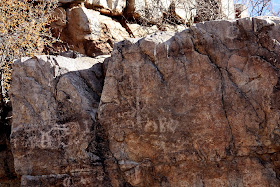I can't leave out our times in Tucson and the years of hiking washes were most special. The older I get, the less I can do it without just memories-- like these two blogs
Tuesday, December 22, 2009
Hiking the washes
 Wherever
I go, I am always interested in rock art (petroglyphs, pictographs) and
usually ask those who might know if they can give directions to such
sites. Many in the Tucson area are in washes (normally dry river or
creek beds).
Wherever
I go, I am always interested in rock art (petroglyphs, pictographs) and
usually ask those who might know if they can give directions to such
sites. Many in the Tucson area are in washes (normally dry river or
creek beds).The washes serve important ecological benefits to the desert as roads for the wildlife and a carrier of water when the heavy rains come-- and they do come. They are somewhat protected, and it might be why they were so often chosen for the rock art. Although, in Tucson, one of the easiest to reach and well preserved sites, Signal Hill, is on the top of a small hill.
Washes are important as a source of water even in dry seasons as you can often dig down in their sand to find water even if the surface is bone dry. Dry washes go from nothing to brim full sometimes very fast (not a good place to live). Flash floods actually drown quite a few people as the water comes from great distances with little advance warning as the deluge doesn't have to be where you even know it's happening. Here, a lot of roadways don't have culverts and instead dip with signs warning don't enter when water is present. More than a few motorists have ignored that to the damage (at the least) of their vehicles.

This particular wash is out in the Tucson Mountains.
 At
one time this was a mining area with quite a few small shafts. Today
it's about a mile hike to a petroglyph site. Although I had expected
just a sandy wash, we were warned by someone coming out of it that our
walking sticks would come in handy. There were rock formations that we
had to scramble up. Not rock climbing but they did make the stick a
handy tool.
At
one time this was a mining area with quite a few small shafts. Today
it's about a mile hike to a petroglyph site. Although I had expected
just a sandy wash, we were warned by someone coming out of it that our
walking sticks would come in handy. There were rock formations that we
had to scramble up. Not rock climbing but they did make the stick a
handy tool.
These deteriorating petroglyphs were likely left by the Hohokam peoples who lived here and then left abruptly as did the Sinagua and Anasazi more to the north around the same time. The Hohokam left behind not only their rock art but also an extensive system of canals whose forms can still be found. The assumption is a major drought drove most of the peoples from their way of life, a few to remain, but most to seemingly disappear into an unwritten history unless you can translate their drawings into their story.

Hiking up a wash Part II
 To
stand where I know people did hundreds of years ago and look at their
rock art is always a very special experience for me. The Hohokam people
occupied central Arizona from around 200 B.C. until about 1450 A.D. when
they, like most of the cliff dwellers to the north (Sinagua and
Anasazi), left at least their established villages and disappeared into
history.
To
stand where I know people did hundreds of years ago and look at their
rock art is always a very special experience for me. The Hohokam people
occupied central Arizona from around 200 B.C. until about 1450 A.D. when
they, like most of the cliff dwellers to the north (Sinagua and
Anasazi), left at least their established villages and disappeared into
history.
As you start to hike up this particular wash, in the foothills of the Catalinas, there are owls that nest under an overpass. From the drawings, it appears that they have always been here.

Do enlarge the photos, especially the one of me because it was one of those lucky shots. We didn't know when it was taken that the waning moon was also in the shot. You couldn't plan a shot like that if you wanted and yet here it was with three elements come together-- the symbols of a people long ago, a person from today, and the moon representing the cycles of life.

Enjoyed your hiking washes accounts. We never did that during the six months I lived in Tucson years ago but I did enjoy the desert as a pre-teen. Years later when we lived in Phoenix/Scottsdale I became much more aware of the washes and how dangerous they could be when rain storms occurred.
ReplyDeleteYes, this is not the season to be unaware of what's around a person. Regularly people get caught in those flash floods :(
ReplyDeleteBeautiful and amazing! Thanks for sharing. A few years ago, my wife and I hiked nine-mile canyon in Utah and marveled at the petroglyphs left behind by the Fremont and Ute people centuries ago. I, like you, have always felt a sense of sacredness about such places.
ReplyDeletehttps://savingcommonsense.blogspot.com/2016/10/to-escape-and-to-find-beauty.html